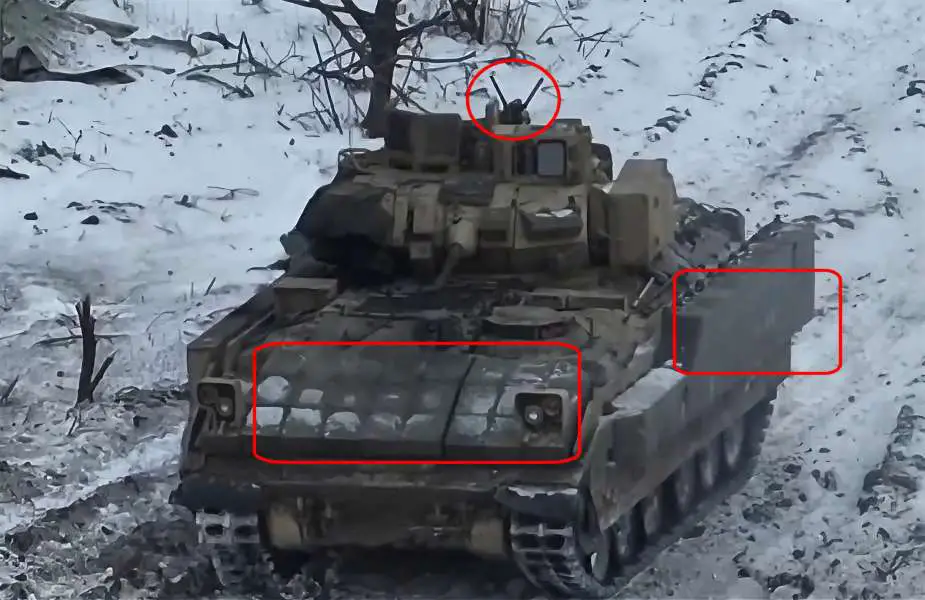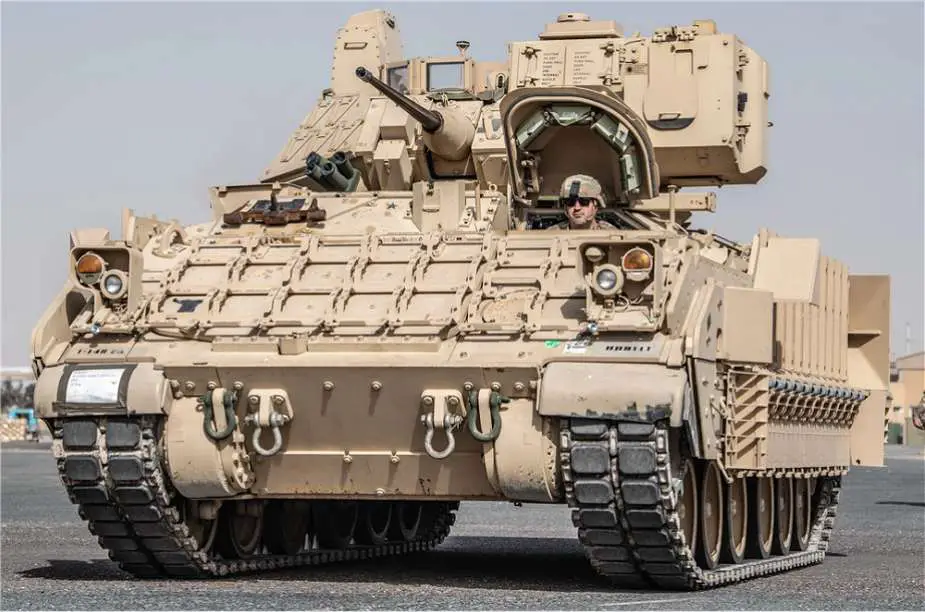Ukraine's US-Donated M2A2 Bradley IFVs Upgraded with Extra Armor & Counter-Drone Solution
Recent pictures published on social networks reveal that the US-donated Bradley M2A2 tracked armored Infantry Fighting Vehicles (IFVs), currently utilized by the Ukrainian armed forces, are now equipped with additional reactive armor. This armor is mounted on the front and sides of the hull and includes a counter-drone electronic warfare solution. The armor appears to be very similar to that mounted on the American M2A3 Bradley.
Follow Army Recognition on Google News at this link

Ukrainian army M2A2 Bradley tracked armored IFV Infantry Fighting Vehicle equipped with additional armor and anti-drone solution. (Picture source Social Network)
It seems that the American M2A2 Bradley tracked armored IFVs (Infantry Fighting Vehicles) in service with the Ukrainian army are fitted with appliqué steel armor with additional passive armor and Explosive Reactive Armour (ERA). The ERA consists of 96 tiles fixed to the sides, turret, and front of the vehicle, which enhances protection against a variety of anti-armor munitions including shoulder-launched Rocket Propelled Grenades (RPG).
The additional appliqué armor provides better protection against small arms fire, artillery shell splinters, and certain types of anti-tank missiles while the explosive reactive armor (ERA) is effective against shaped charges and can significantly enhance the vehicle's survivability against anti-tank guided missiles and rocket-propelled grenades.
The introduction of drones and First-Person View (FPV) technology in the war in Ukraine has brought about significant changes in modern warfare. Drones provide a low-cost, yet effective means for surveillance and intelligence gathering. They can be deployed to monitor troop movements, fortifications, and civilian areas, offering a significant advantage in a conflict where information is key. The FPV technology, on the other hand, allows operators to control drones with heightened precision and maneuverability. This is particularly useful for navigating through complex environments like urban areas or dense forests, enhancing their effectiveness in targeted operations.
Furthermore, drones equipped with FPV have transformed the nature of aerial combat and reconnaissance. They enable real-time data transmission, providing immediate battlefield intelligence that can be pivotal in making strategic decisions. This technology also poses a new set of challenges in terms of airspace control and counter-drone strategies. The ability of these drones to operate discreetly and penetrate enemy lines without risking human lives makes them a formidable tool in modern warfare.
Additionally, the use of drones in the Ukraine conflict underscores the evolving nature of warfare, where asymmetric tactics and technology play a crucial role. It represents a shift from traditional, heavy military equipment to more agile, technology-driven solutions that can offer tactical advantages in various scenarios. This evolution raises concerns about the future of warfare, where non-state actors or smaller nations could leverage such technologies to challenge larger, more established military forces.

A U.S. Army Bradley M2A3 IFV Infantry Fighting Vehicle equipped with additional armor including appliqué steel armor with additional passive armor and Explosive Reactive Armour (ERA). (Picture source U.S. DoD)
To counter these new threats the Bradley M2A2 IFVs of the 47th Brigade of the Ukrainian Armed Forces are equipped with an anti-drone electronic warfare system. The jamming solution in counter-drone electronic warfare involves a series of steps designed to neutralize unmanned aerial vehicles (UAVs) or drones, which are becoming increasingly prevalent in various contexts. The primary objective of jamming is to disrupt the communication and navigation systems of a drone, rendering it ineffective or forcing it to land.
When a potential drone threat is detected, the jamming solution springs into action. It starts by targeting the communication channels of the drone. Drones typically communicate with their operators or with GPS satellites using specific radio frequencies. Jamming equipment broadcasts strong interference signals at these frequencies, effectively drowning out the genuine control or navigation signals.
This interference disrupts the drone's ability to receive commands from its operator, as well as its access to GPS signals necessary for navigation. Without these crucial inputs, most drones will either enter a fail-safe mode, which might involve returning to a predefined location or slowly descending to land, or they may simply hover in place until their power runs out.
Some advanced jamming solutions can also employ more targeted strategies, like spoofing. In spoofing, the jammer sends false signals that mimic the legitimate control or GPS signals. This can trick the drone into following false commands, allowing the jammer to take control of the drone's flight path indirectly.
Jamming solutions are essential in various scenarios, including protecting military installations, airports, sensitive political or commercial venues, and even in preventing espionage or terrorist activities. However, they must be used with caution, as indiscriminate jamming can interfere with legitimate communications and navigational tools in the area.
The effectiveness of a jamming solution largely depends on the sophistication of the drone's design and its resistance to signal interference. Some high-end military drones are equipped with anti-jamming technology, making them more challenging to neutralize using standard jamming techniques.
News Russia Ukraine War




























